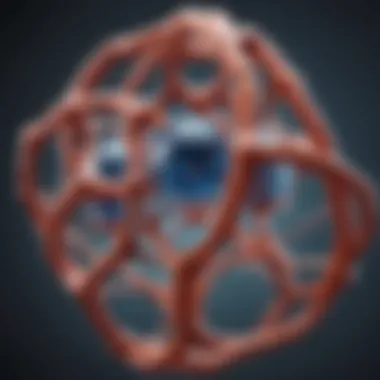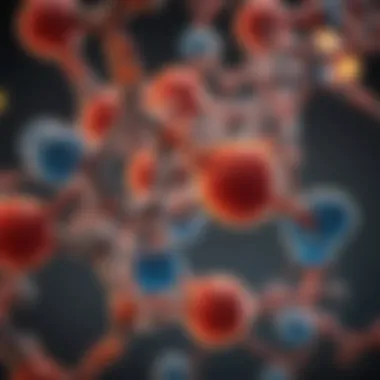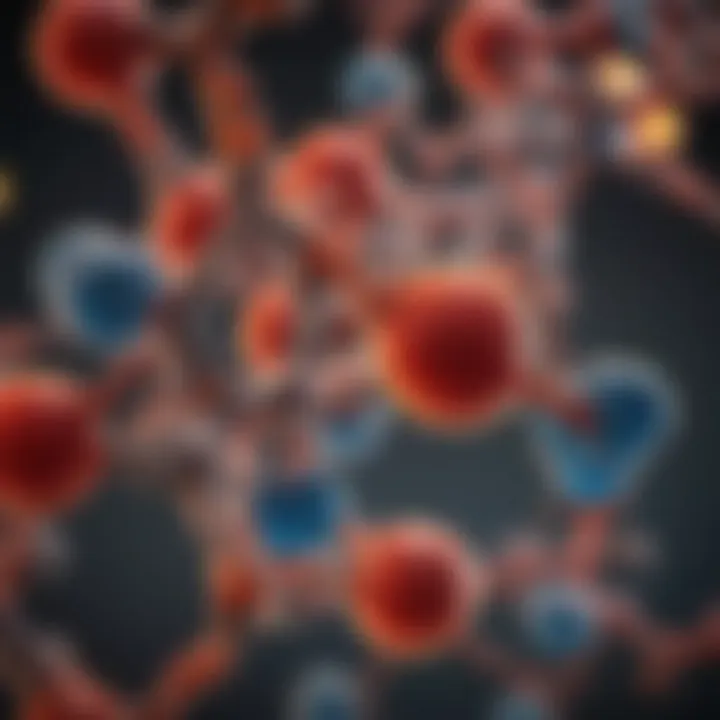Organic Chemistry: Key Concepts and Real-World Applications


Intro
Organic chemistry is often likened to a veritable treasure trove of knowledge that underpins so much of our world—from the medicine we take to the food we eat. This branch of chemistry focuses on the study of carbon-containing compounds, a vast array of substances that shape the very fabric of life. Understanding organic chemistry lays the groundwork for grasping complex scientific principles and applications, providing insights not only for students but for professionals in various fields, such as pharmaceuticals, environmental science, and materials research.
Overview of Research Topic
Brief Background and Context
Organic chemistry has roots stretching back to the 19th century when scientists began to realize that carbon had a unique ability to form countless compounds. Louis Pasteur and Dmitri Mendeleev were among those who recognized its significance. Fast forward to today, organic compounds play pivotal roles in diverse areas. They are found in everything from the simplest sugars to the most intricate drugs. Understanding their complexity is like unraveling a fine tapestry woven with countless threads.
Importance in Current Scientific Landscape
In today’s fast-paced world, the relevance of organic chemistry is more pronounced than ever. Recent advancements in areas such as drug development and environmental sustainability can all be traced back to organic chemistry. The discovery and synthesis of new compounds, the characterization of molecular structures, and the exploration of reaction mechanisms do not merely appease academic curiosity; they address pressing global challenges such as disease management and ecological preservation. Organic chemistry provides the tools necessary to innovate and find solutions.
"Organic chemistry transforms the way we approach healing, sustainability, and materials science."
Methodology
Research Design and Approach
The exploration of organic chemistry involves a mix of theoretical and practical aspects. Students often start with foundational principles before advancing to more complex topics involving reaction mechanisms, analytical techniques, and molecular modeling. Incorporating hands-on laboratory work enables students to apply theoretical concepts in real-world settings, making the learning experience both engaging and practical.
Data Collection Techniques
Different methods are employed for collecting data in organic chemistry research. Wet lab experiments are essential for observing chemical reactions and understanding properties of compounds firsthand. In addition, simulation software allows researchers to model chemical interactions and predict outcomes without the need for physical experimentation. This combination of techniques plays a key role in shaping our understanding and uncovering the vast potential of organic substances.
Organic chemistry stands at the core of scientific endeavor, weaving paths across various disciplines. This article will further delve into the intricacies of organic compounds and their multifaceted applications.
Prolusion to Organic Chemistry
Organic chemistry stands as a cornerstone of modern chemical science, encapsulating the study of carbon-containing compounds and the myriad ways they interact. Its significance extends beyond the confines of classrooms and laboratories, influencing fields as diverse as pharmaceuticals, environmental science, and materials development. By dissecting organic compounds, chemists can unveil the nature of substances that are ubiquitous in daily life—from the air we breathe to the food we consume.
This article aims to provide a thorough overview of organic chemistry, its essential principles, and how it applies to various domains. The importance of organic chemistry cannot be overstated; it's the bridge that connects simple elements like carbon and hydrogen into complex molecules with profound implications. In delving into this field, one not only learns about the components that make up natural substances but also gains insights into innovative applications that can solve real-world challenges.
Definition and Scope
Organic chemistry is broadly defined as the branch of chemistry dealing with carbon compounds, which include not only hydrocarbons but also a variety of derivatives that contain functional groups like oxygen, nitrogen, or sulfur. The scope of organic chemistry is extensive. It envelops the synthesis, structure, reactions, and properties of organic molecules, leading to applications that span sectors like drug development, petrochemicals, and polymers.
This vastness manifests in several distinct but overlapping areas, such as:
- Synthetic Organic Chemistry: The design and synthesis of new organic compounds.
- Physical Organic Chemistry: Studying the relationship between chemical structures and reactivity.
- Biochemistry: Examining the molecular mechanisms within biological systems, which fundamentally rely on organic compounds.
Understanding this interconnectivity allows researchers and students alike to appreciate how organic chemistry serves as a foundational discipline that touches nearly every aspect of science and technology today.
Historical Background
The roots of organic chemistry trace back to ancient civilizations, where the earliest chemists, often termed alchemists, sought to transform base metals into gold and find the secret to immortality. However, it was during the 18th and 19th centuries that organic chemistry gained recognition as a distinct field of study. Notable figures such as Friedrich Wöhler, who synthesized urea in 1828, helped to debunk the misconception that organic compounds could only be derived from living organisms, a theory known as vitalism.
The evolution of organic chemistry continued through pivotal discoveries, including:
- The formulation of structural theory by August Kekulé and Archibald Scott Couper, which laid down the framework for understanding molecular structures.
- The establishment of reaction mechanisms, significantly advanced by chemists like Elias James Corey, who won a Nobel Prize for his contributions to the development of retrosynthetic analysis.
- Recent trends in green chemistry which emphasize sustainable practices and reducing ecological footprints.
Today, organic chemistry is a dynamic and continually evolving field that underpins numerous scientific advancements. Its historical journey reflects not only a timeline of scientific achievements but also a narrative that encapsulates the spirit of inquiry and innovation.
Fundamental Concepts
Understanding the foundational aspects of organic chemistry is crucial for anyone stepping into this intricate field. This section will dissect the basic structure of organic compounds, the pivotal role of functional groups, and the complexities of stereochemistry and isomerism. Grasping these fundamental concepts not only aids in mastering organic reactions but also paves the way for exploring advanced topics and applications.
Basic Structure of Organic Compounds
Organic compounds mainly consist of carbon atoms. Carbon possesses a unique ability to form stable bonds with itself and with various other elements. This characteristic allows for a diverse range of structures. Imagine a spider weaving its intricate web—each strand represents a bond, and every junction signifies a carbon atom.


- Alkanes: Saturated hydrocarbons like propane and butane, which only have single bonds.
- Alkenes and Alkynes: Unsaturated hydrocarbons containing double and triple bonds, respectively, with compounds such as ethylene and acetylene.
The presence of these structures not only defines the identity of organic molecules but also influences their reactivity and physical properties. For instance, the straight-chain formation of a hydrocarbon can yield different boiling points compared to its branched counterpart, altering its application in everyday life.
Importance of Functional Groups
Functional groups are specific atoms or groups of atoms that determine the characteristic reactions of a compound. Think of them as a vehicle's modifications—adding a turbocharger changes how it behaves on the road. They can either attract or repel other molecules based on their chemical nature.
- Hydroxyl group (-OH): Present in alcohols which makes them polar and soluble in water.
- Carboxyl group (-COOH): Found in organic acids, contributing to acidity and reactivity.
The position and type of these groups are fundamental in predicting the reactivity of organic compounds. Understanding the various functional groups sets the stage for advanced studies in synthesis and reaction mechanisms, illustrating how slight changes can lead to significant effects on a compound's behavior.
Stereochemistry and Isomerism
Stereochemistry delves into how different spatial arrangements of atoms affect a compound's properties and behavior. This is an important area, as even subtle variations in structure can lead to drastically different outcomes. Consider the analogy of a person’s silhouette—while it may appear quite similar from different angles, the actual appearance can vary significantly.
Isomers fall into two primary categories:
- Structural Isomers: Compounds with the same molecular formula but different connectivity. For example, butanol and isobutanol.
- Stereoisomers: Compounds with the same molecular formula and connectivity but different spatial orientations, like cis and trans isomers in unsaturated compounds.
Understanding these distinctions is vital, especially in the field of pharmaceuticals, where one stereoisomer may have therapeutic effects while the other may be harmful. By grasping the concepts of stereochemistry and isomerism, one can better appreciate the subtleties of organic chemistry and its profound implications in practical applications.
"The path to understanding organic chemistry is paved with fundamental concepts that shape our grasp of its beauty and complexity."
Organic Reactions
Understanding organic reactions is fundamentally essential in the realm of organic chemistry. These reactions form the backbone of chemical transformations that drive everything from synthetic processes in pharmaceuticals to the natural processes within living organisms. By comprehending how organic reactions work, students and professionals gain not only theoretical knowledge but also practical applications that relate to everyday life, industry, and environmental concerns.
Organic reactions can be categorized into several types, each serving a unique purpose and application. Recognizing these different types enables one to predict how specific substances will behave under various conditions, which is crucial in fields such as drug design and environmental science.
Types of Organic Reactions
Organic reactions generally fall into several classic categories:
- Substitution Reactions: In these reactions, one functional group in a compound is replaced by another. An everyday example is how halogens, like chlorine, can substitute hydrogen atoms in hydrocarbons. This can modify the properties and reactivity of the compound significantly.
- Addition Reactions: Common in alkenes and alkynes, where atoms or groups are added to multiple bonds. Consider the hydrogenation of vegetable oils, a process widely utilized in food chemistry. With this reaction, unsaturated fats become saturated, altering their melting points and stability.
- Elimination Reactions: The opposite of addition reactions, where elements are removed from a compound. This type often leads to the formation of double or triple bonds. An example is the dehydration of alcohols to form alkenes, an essential step in organic synthesis.
- Rearrangement Reactions: These entail the reorganization of the molecular structure, leading to a different isomer. A well-known case involves the conversion of glucose into fructose. This reaction can drastically change the bioavailability of the carbohydrate in metabolic processes.
Each type of reaction showcases distinct pathways and mechanisms, leading to a diverse array of products and applications.
Reaction Mechanisms
Diving into reaction mechanisms reveals the step-by-step processes through which reactants transform into products. Each mechanism encompasses a series of elementary steps governed by the laws of chemistry. Learning about these mechanisms is akin to following a recipe; knowing each step ensures a successful outcome.
Consider electrophilic addition as an example. Initially, a nucleophile interacts with an electrophile, forming a temporary species before ultimately yielding the desired product. This knowledge is vital for chemists who wish to manipulate conditions to steer the reaction towards a preferred product.
Understanding these mechanisms often leads to more efficient synthesis pathways, optimizing yield and reducing waste—a crucial consideration in green chemistry practices.
Kinetics and Thermodynamics in Organic Chemistry
The study of kinetics involves understanding the rates at which reactions proceed, while thermodynamics assesses the energy changes accompanying these processes. Both are instrumental in organic chemistry, guiding chemists in designing and predicting the outcomes of reactions.
- Kinetics helps answer questions such as: Why does one reaction occur faster than another? It explores factors affecting reaction speed, such as concentration, temperature, and catalysts. Knowing these factors can enable chemists to refine reactions, speeding up processes in drug manufacturing, for example.
- Thermodynamics, on the other hand, evaluates the favorability of reactions. It can elucidate why certain reactions are spontaneous under specific conditions while others require additional energy. This is especially important when evaluating reaction pathways in synthesis, ensuring that energy costs are minimized and sustainability is prioritized.
"In the landscape of organic chemistry, the interwoven threads of kinetics and thermodynamics act as a compass, guiding chemists on the path of rational design and innovation."
Collectively, a solid grasp of organic reactions, their mechanisms, and their associated kinetics and thermodynamics lays the groundwork for continued advancements in organic chemistry. This investigation into reactions is not just an intellectual pursuit; it has real-world implications in industries ranging from pharmaceuticals to environmental technology, demonstrating the immense value of understanding the art and science of organic reactions.
Advanced Topics in Organic Chemistry
Exploring the advanced topics in organic chemistry provides a gateway into the more intricate aspects of the field. These subjects are not just academic exercises; they hold significant relevance in real-world applications, shaping industries such as pharmaceuticals, materials science, and environmental conservation. By delving deeper into these areas, researchers and students alike can glean insights that could lead to innovative solutions for today’s pressing challenges.
Organometallic Chemistry
Organometallic chemistry sits at the intersection of organic and inorganic chemistry. By studying compounds containing metal-carbon bonds, this field opens up a treasure chest of possibilities. These compounds play a fundamental role in catalysis, drug design, and polymer production.


One can hardly underestimate the benefits organometallic compounds bring to synthesis. For instance, the use of palladium-catalyzed cross-coupling reactions allows chemists to create complex organic molecules in a single step. This efficiency is invaluable in drug discovery, where the rapid development of new compounds can spell the difference between success and failure in developing new treatments.
Furthermore, the advances in this field often lead to breakthroughs in sustainable practices. By utilizing organometallic compounds in reactions, the need for harsh reaction conditions can be minimized, thus reducing waste and environmental impact.
Supramolecular Chemistry
Supramolecular chemistry focuses on the study of molecular assemblies held together by non-covalent interactions. While traditional organic chemistry is concerned with individual molecules and their covalent bonding, supramolecular chemistry broadens the perspective to consider how molecules interact and assemble into larger structures. This field holds immense potential for drug delivery systems, where the encapsulation of drugs within supramolecular structures can enhance the therapeutic efficacy and specificity of treatments.
Applications extend to materials science, particularly in creating new materials with desirable properties. Think about how nature designs its systems: enzymes, proteins, and even DNA show a remarkable ability to assemble into functional units. Mimicking these structures in artificial systems can lead to innovative biomaterials, sensors, and nanotechnology applications.
- Key Points about Supramolecular Chemistry:
- Focus on non-covalent interactions enables more dynamic systems.
- Enhances the efficacy of drug delivery methods.
- Presents opportunities for novel material development.
Green Chemistry Principles
In today's world, the push towards sustainability has initiated a profound transformation in the approach to chemistry. Green chemistry principles focus on designing chemical processes that minimize waste and reduce environmental impact, all while maintaining the efficiency and effectiveness of chemical reactions. This is often encapsulated in the 12 principles of green chemistry, which promote the use of renewable resources and energy-efficient processes.
What does this mean for organic chemistry? Practitioners are increasingly encouraged to adopt environmentally friendly solvents, reduce byproducts, and seek safer, biodegradable alternatives to traditional reagents. For instance, the transition from traditional synthesis methods to microwave-assisted synthesis exemplifies how green chemistry principles can lead to reduced energy consumption and shorter reaction times.
- Benefits of Green Chemistry:
- Minimizes waste generation and energy use.
- Promotes safer chemical processes and products.
- Addresses the needs of both the economy and the environment.
"Incorporating green chemistry principles is not just a trend; it is an essential shift that future chemists must embrace to ensure that our discipline remains relevant in an increasingly eco-conscious world."
To sum up, these advanced topics in organic chemistry are more than mere theoretical constructs. They provide critical tools and insights that drive progress across various sectors. Embracing organometallic chemistry, supramolecular chemistry, and green chemistry principles empowers scientists to not just understand but also reshape the chemical landscape.
Applications of Organic Chemistry
Organic chemistry plays a pivotal role in numerous fields, significantly shaping industries and innovation. Understanding its applications not only helps in academic pursuits but also illuminates its crucial contributions to society. This section delves into various practical aspects of organic chemistry, giving special attention to its impact on pharmaceuticals, environmental sustainability, and food safety.
Role in Pharmaceutical Development
The pharmaceutical sector is arguably one of the most prominent areas where organic chemistry shines. From the very inception of a drug's development to its ultimate delivery to the market, organic chemistry is at the forefront. Here’s how:
- Drug Design and Development: Organic chemists are responsible for synthesizing new pharmaceutical compounds. These chemists often use structure-activity relationship (SAR) studies to develop molecules that can interact with biological targets effectively. The ability to manipulate molecular structures allows for the innovation of drugs that can treat diseases more effectively than earlier options.
- Quality Control and Synthesis: After the initial discoveries, rigorous testing takes place. Organic chemistry is essential for ensuring that the drugs produced meet the required safety and effectiveness standards. Techniques like chromatography and spectroscopy are commonly utilized to analyze the purity of an active ingredient.
- Biotechnology Integration: The intersection of organic chemistry and biotechnology has led to biopharmaceuticals, which are increasingly gaining traction. Pharmacogenomics, a branch combining chemistry and genetics, aids in personalizing medicine, thus enhancing therapeutic efficacy and minimizing side effects.
This intersection reveals how organic chemistry's ingenuity can lead to life-saving therapies, highlighting its indispensable role in modern medicine.
Environmental Impacts and Sustainability
Organic chemistry doesn’t just serve human health; it plays a critical part in addressing environmental challenges. As global consciousness regarding sustainability grows, organic chemistry contributes to finding solutions:
- Green Chemistry: This principle emphasizes reducing waste and using safer chemicals. It seeks to design chemical processes that minimize the production of hazardous substances. For instance, chemists have developed more efficient catalysts that reduce the energy required for reactions, leading to lesser carbon emissions.
- Biodegradable Materials: Organic chemists are at the forefront of creating polymers that break down more easily in the environment. These innovations can mitigate plastic pollution, one of the pressing concerns of our time. Efforts to create materials like polylactic acid (PLA) showcase how organic chemistry directly impacts sustainability.
- Remediation Techniques: Methods to decontaminate the environment, such as using organic solvents to extract pollutants, are studied within this field. Strategies for soil and water remediation leverage organic reactions to neutralize harmful compounds, ensuring a cleaner planet for future generations.
"The talents of organic chemists are indispensable not just for advancements in medicine, but also for sustainability and environmental preservation."
Food Chemistry and Safety
In the realm of food, organic chemistry's influence is profound. It is deeply intertwined with food safety, quality, and nutrition:
- Food Additives and Preservatives: Organic chemists develop preservatives and flavor enhancers that improve food shelf life and taste. Understanding the reactions that can spoil food allows for the innovation of natural preservatives that are safer and healthier for consumers.
- Nutritional Chemistry: The study of how different compounds in food affect human health falls under the umbrella of organic chemistry. For example, understanding how phytochemicals from plants can impact health can lead to new dietary recommendations or even the development of functional foods that offer health benefits beyond basic nutrition.
- Analytical Chemistry in Food Safety: Techniques derived from organic chemistry are used in food testing to detect harmful compounds or pathogens. Methods like mass spectrometry and gas chromatography ensure that the food we consume is safe and healthy.
In summary, organic chemistry touches nearly every aspect of our lives. Its applications in pharmaceuticals, sustainability efforts, and food safety underline its significance. By acknowledging these applications, we gain an appreciation for the intricate connections between chemical principles and real-world solutions.
Educational Approaches in Organic Chemistry
Organic chemistry, though often seen as a complex maze of structures and reactions, can be navigated efficiently through tailored educational approaches. The significance of these methods lies not only in imparting knowledge but also in kindling a genuine interest in the discipline. As organic chemistry is foundational for various scientific paths, understanding how it is taught can impact a student's grasp of essential concepts, thereby shaping their academic and professional journey.
Effective Study Strategies
Mastering organic chemistry requires more than rote memorization; it involves a blend of understanding concepts and applying them. Here are some study strategies that can facilitate a deeper understanding:


- Active Learning: Engaging with the material through group discussions or teaching peers can solidify knowledge. Knowing that you have to explain a concept to someone else can push you to understand it more thoroughly.
- Visual Aids: Utilizing molecular model kits or software tools can help to visualize three-dimensional structures which are vital in organic chemistry. Seeing how molecules interact can often clarify abstract concepts.
- Practice Problems: Attempting various problems rather than just reading through the material helps reinforce learning. It’s been found that actively solving organic reactions leads to better retention than passive review.
- Mnemonic Devices: Creating memorable phrases for functional groups or reaction mechanisms can aid recall during examinations. For instance, the phrase “Silly Penguins Dive on Ice” might remind students of the hellish properties of sulfuric acid.
Incorporating these strategies transform learning from a chore into a more digestible and engaging process.
Laboratory Techniques in Teaching
Laboratories are often the heartbeat of organic chemistry education. Here’s how practical lab techniques play a key role:
- Hands-On Experience: Students have an opportunity to experiment with compounds. This hands-on approach not only reinforces theoretical knowledge but also heightens interest through active participation.
- Safety Protocols: Learning to navigate the laboratory environment ensures that students comprehend the importance of safety in handling chemicals, an essential component of any lab work.
- Real-Life Applications: Experiments often simulate real-world problems. For example, synthesizing a common drug can bridge the gap between theoretical knowledge and practical implications, demonstrating the relevance of organic chemistry.
Effective laboratory techniques inspire confidence in students, arming them with skills that extend beyond the classroom into professional realms.
Use of Technology in Learning
In today's digital age, integrating technology into organic chemistry education is not just beneficial; it’s essential. Here are a few avenues through which technology transforms learning:
- Online Simulations: Platforms like PhET provide interactive simulations that allow students to visualize complex reactions and molecular interactions.
- Virtual Labs: Online laboratory simulations offer a safety net for students, especially when resources are limited. These labs can provide instant feedback in a virtual environment, an advantage often absent in traditional settings.
- Educational Apps: Apps such as ChemDoodle can facilitate molecular visualization on smartphones. Students can manipulate structures to aid in their understanding and retention of organic compounds.
Technology not only supplants traditional resources but also enhances the learning experience, making organic chemistry more accessible and engaging.
"In organic chemistry, the way we teach can transform a daunting subject into a captivating exploration of the molecular world.”
The above approaches highlight that understanding organic chemistry is more than just memorizing reactions; it involves connecting dots between theoretical knowledge and practical application. By refining educational techniques, teachers can foster an environment where curiosity thrives, ultimately leading to a generation of chemists who appreciate the beauty and importance of organic chemistry in their lives.
Research and Innovation in Organic Chemistry
Research and innovation in organic chemistry stand as the backbone of advancements in numerous scientific fields. This dynamic area not only drives the evolution of chemical science but also contributes to the development of sustainable solutions for many challenges in society. From pharmaceuticals to materials science, the integration of cutting-edge research informs how we understand molecular interactions and the design of new compounds.
One of the key aspects of research in organic chemistry is its impact on the pharmaceutical industry. By exploring novel synthetic routes and discovering new functional groups with therapeutic potential, researchers can create advanced drug candidates that target diseases more effectively. Moreover, with the rise of personalized medicine, organic chemistry plays a crucial role in tailoring pharmaceuticals to individual genetic profiles, fostering more effective treatments with fewer side effects.
Development of sustainable methods for organic synthesis is also a major focus. As we grapple with environmental concerns, the shift towards green chemistry methodologies ensures that organic reactions are not just efficient but also minimize waste and reduce hazardous byproducts. This paradigm shift has led to the introduction of alternative solvents, catalysts, and reagents that are more friendly to our planet.
"The integration of research and innovation in organic chemistry is essential for addressing global challenges, from health to environmental sustainability."
Furthermore, the collaboration between organic chemists and other scientific fields is gaining traction. As we delve deeper into interdisciplinary research, the synergy among different disciplines—like biology, materials science, and nanotechnology—fosters innovation that was once unimaginable.
Emerging Trends in Organic Synthesis
Emerging trends in organic synthesis reflect the collaborative spirit of modern science. Notably, automation and artificial intelligence are making waves in this traditional field. The advent of automated synthesis platforms is revolutionizing how chemists conduct experiments. For example, robots can carry out high-throughput screening of reactions, allowing scientists to explore numerous conditions that would be labor-intensive if done manually.
Moreover, machine learning algorithms are being harnessed to predict reaction outcomes based on previously collected data. This approach can drastically reduce the trial and error process characteristic of organic synthesis, paving the way to discover new compounds at an accelerated pace.
Key Trends Include:
- Automated High-Throughput Screening: Increase efficiency in testing multiple reaction conditions.
- Machine Learning Integration: Evolving predictive models for reaction optimization.
- Biologically Inspired Synthesis: Using natural processes as templates for synthetic pathways.
These advancements not only enhance productivity but also open doors for innovative approaches in creating complex molecules crucial in drug development.
Collaboration Across Scientific Fields
Collaboration across scientific fields has become paramount in driving research in organic chemistry to new heights. The synthesis of complex organic molecules often requires interdisciplinary knowledge, where chemists work alongside biologists, physicists, and engineers to address multifaceted problems.
For instance, when developing new materials, organic chemists can collaborate with materials scientists to design polymers that offer enhanced properties for electronics or biomedical applications. This cross-pollination of ideas leads to groundbreaking discoveries and innovative solutions that may not have surfaced through traditional research methods alone.
Noteworthy collaborations can be observed in:
- Pharmaceuticals: Chemists and biologists come together to innovate drug design and screening strategies.
- Nanotechnology: Collaborations result in the development of nanoscale materials with fine-tuned properties for electronics and diagnostics.
- Environmental Science: Chemists work with environmental scientists to create biodegradable materials that lessen pollution.
Future Directions and Challenges
Looking ahead, the future of organic chemistry is ripe with opportunities and challenges. One pressing issue is the need for sustainable and economically viable synthetic methods. As global regulations tighten around chemical production, chemists are pushed to find greener solutions, integrating renewable resources without compromising quality.
Moreover, the integration of digital technology and data science will continue to shape the landscape of organic research. While these advancements promise enhanced efficiency, they also require chemists to develop new skill sets to interpret the vast amounts of data generated.
Key challenges ahead include:
- Sustainability: Developing methods that conserve resources and minimize waste.
- Skill Development: Training the next generation of chemists in computational tools and automation.
- Interdisciplinary Approaches: Emphasizing teamwork across scientific domains to tackle complex societal issues.
In essence, research and innovation in organic chemistry are critical components in shaping the future of science and its applications. By staying at the forefront of these trends, the field can continue to address pressing needs within health, environment, and technology, empowering the next generations of scientists.



